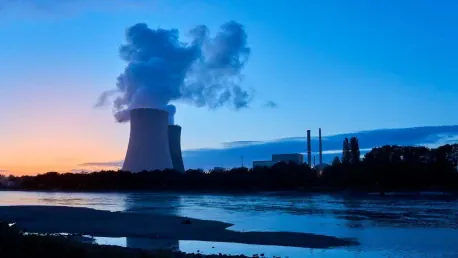In recent years, tech giants known as hyperscalers, which include Amazon, Google, and Microsoft, have been increasingly investing in nuclear power to meet their skyrocketing energy demands. This trend is driven by a combination of the rapidly rising need for computational power and the urgency to minimize the environmental impact of data centers. Small modular reactors (SMRs) in particular have caught the attention of these companies as a stable, reliable, and carbon-free energy source, promising to address both energy gaps and sustainability concerns.
The Growing Energy Demands of Data Centers
Rising Energy Consumption
Data centers are becoming energy behemoths, significantly contributing to the overall energy consumption of the tech industry. According to recent studies, approximately 60% of energy production in the United States and 33% in the United Kingdom still depend on fossil fuels, increasing environmental concerns as data center activities grow. These tech firms have recognized the necessity for self-sufficiency in energy generation to ensure stable operations while addressing sustainability. Nuclear energy, particularly through nuclear fission, presents a promising solution, producing nearly 19% of the electricity in the U.S. and 13% in the UK without carbon emissions.
The rising consumption of energy by data centers is causing hyperscalers to rethink their energy strategies. The McKinsey Global Institute has estimated the current global data-center-critical IT demand at around 60 gigawatts, with expectations of this figure soaring to between 170 and 220 gigawatts by the decade’s end. Such an increase necessitates a tripling in energy capacity. Goldman Sachs has projected that data centers could account for 8% of the total U.S. electricity demand by 2030, up from today’s 3%. AI technology, particularly generative AI, could balloon into a $4 trillion market. Associatively, having a reliable and possibly proprietary electricity supply becomes a strategic priority for these companies.
Addressing Power Supply Challenges
Securing a stable and sufficient energy supply is essential not only to support the tech industry’s ambitions but also to guarantee future relevance and competitiveness. This urgency is pushing hyperscalers to explore various avenues for power, predominantly from nuclear energy. Nuclear power can provide an uninterrupted and zero-carbon emission solution, aligning well with hyperscalers’ goals. Additionally, the impending demands necessitate foresight and strategic investments in infrastructure capable of scaling up rapidly in the face of growing needs.
As the demand for electricity continues to rise, so too does the complexity of managing energy sources. Hyperscalers understand that their reliance on traditional grid power may not be sufficient, given the substantial growth in energy consumption anticipated. By integrating nuclear energy solutions such as SMRs, these tech giants can ensure a more efficient, scalable, and resilient energy strategy. This proactive approach demonstrates not only an investment in technology but also a commitment to sustainable practices that can mitigate the environmental impact associated with massive data processing and storage.
Environmental Concerns and Greenhouse Gas Emissions
The Need to Reduce Emissions
As data centers continue to proliferate, the environmental footprint of these operations becomes more significant. The United Nations has reported that greenhouse gas emissions reached unprecedented levels in 2023, increasing by 1.3% from the prior year, escalating even faster than the average increase over the past decade. Hyperscalers are under tremendous pressure to adopt sustainable practices that align with global climate targets. To curtail emissions effectively, ambitious strategies must be implemented.
Significant emphasis is placed on reducing carbon footprints across the tech industry, and hyperscalers are no exception. Data centers contribute notably to greenhouse gas emissions, compelling industry leaders to seek zero-carbon energy sources. By migrating to nuclear energy, particularly through the adoption of SMRs, hyperscalers can take a giant leap towards sustainability. Nuclear power is capable of producing large amounts of energy with minimal greenhouse gas emissions, offering a promising solution to help hyperscalers achieve their energy and environmental goals simultaneously.
Hyperscalers’ Decisive Moves
In light of the rising need for energy and the pressing call for sustainability, hyperscalers are committing to nuclear energy solutions. Each company has laid out specific plans for incorporating nuclear power into their energy strategies. Amazon Web Services (AWS), Google, and Microsoft are at the forefront of this movement, evidencing a steadfast commitment to cleaner, more reliable energy sources. These investments not only signal environmental responsibility but also strategic foresight in meeting future energy demands.
Nuclear energy is seen as the linchpin in these companies’ strategies to combat power supply challenges while minimizing their environmental impact. The shift to nuclear power is not merely a short-term solution; it represents a long-term vision that aligns with both energy security and sustainability. This multifaceted approach involves partnerships with innovative startups, significant investments, and agreements with utility providers to ensure the smooth and reliable provision of nuclear energy. By taking these decisive steps, hyperscalers are setting the stage for a future where data center operations are both energy-efficient and environmentally friendly.
Amazon’s Investment in Nuclear Power
AWS’s Nuclear Power Projects
Amazon Web Services (AWS) has committed over $500 million to nuclear power projects aimed at powering its expansive network of data centers. This substantial investment primarily focuses on small modular reactors (SMRs). AWS’s ambitious initiative includes three key projects stretching from Virginia to Washington State. Working in conjunction with nuclear technology startup X-energy, AWS aims to develop and harness nuclear power through partnerships with utility companies in these regions. Although AWS is not directly involved in constructing or operating these reactors, it seeks to purchase the zero-emission energy produced, ensuring a steady supply to its operations.
These strategic investments underline AWS’s commitment to a sustainable energy future. By targeting nuclear power, particularly SMRs, AWS hopes to secure a reliable and carbon-free energy source. An agreement to source nuclear power-generated electricity from a Pennsylvania nuclear power station exemplifies AWS’s forward-thinking approach. This scheme not only reinforces AWS’s position as an industry leader in sustainable practices but also highlights the growing feasibility and attractiveness of nuclear power as a major player in the energy matrix for data centers.
Google’s Dual Approach: Nuclear and Solar
Investment in SMRs and Solar Power
Google’s energy strategy incorporates investment in both nuclear and solar power, showcasing a diversified approach to meeting its energy needs. Partnering with Kairos Power, Google intends to deploy an SMR by the year 2030. This collaboration is a testament to Google’s commitment to nuclear energy as a backbone for its future growth. Moreover, Google’s engagement in the most significant solar power purchase agreement to date exemplifies its broader commitment to renewable energy. The solar farm project, operated by SB Energy, boasts over 1.3 million solar modules, adding 875 megawatts of capacity to the Texas grid and providing substantial power to Google’s data centers within the state.
By combining nuclear power through SMRs and renewable energy from its expansive solar farm, Google is showcasing a comprehensive approach to energy sustainability. This dual strategy addresses near-future energy demands while ensuring that the sources remain environmentally friendly. Google’s investments in both sectors demonstrate its commitment to reducing its carbon footprint, setting a powerful precedent for other tech giants to follow suit. The integration of these diverse energy sources highlights the adaptability and forward-thinking nature of Google’s energy plans.
Microsoft’s Nuclear Ambitions
Collaboration with Constellation Energy
Microsoft has taken a bold step in partnering with Constellation Energy for an ambitious nuclear energy project at the infamous Three Mile Island site in Pennsylvania. Set to commence operations in 2028, the Crane Clean Energy Center will leverage state-of-the-art nuclear fission technology to deliver carbon-free power. This facility is planned to continue operations until at least 2054, ensuring Microsoft’s access to sustainable, reliable energy for two decades. Constellation Energy is prepared to invest at least $1.6 billion in this groundbreaking project, indicative of the substantial financial commitments necessary to realize such initiatives.
This collaboration signifies a strategic move by Microsoft to ensure long-term energy sustainability while adhering to stringent environmental standards. The partnership with Constellation Energy also exhibits confidence in nuclear power’s potential to address significant power supply challenges. By investing in a historically notable site for nuclear energy, Microsoft is poised to transform it into a symbol of innovation and green energy transition. This project underscores how historical resources can be repurposed to meet modern-day energy needs sustainably.
Oracle’s Vision for Nuclear-Powered Data Centers
Larry Ellison’s Ambitious Plans
Oracle founder Larry Ellison has also expressed interest in the potential of nuclear energy, contemplating the development of a data center with a gigawatt-plus capacity powered by multiple SMRs. This forward-thinking plan demonstrates Oracle’s exploration of cutting-edge energy solutions to address future demands. The gigawatt-plus data center is not just a conceptual advancement but a reflection of Oracle’s commitment to harnessing advanced nuclear technology. This ambitious approach could significantly influence the broader industry’s perspective on nuclear power’s viability.
Ellison’s envisioning of such an advanced facility underscores the growing confidence in nuclear energy among leading hyperscalers. By exploring the design and implementation of a massive data center powered by multiple SMRs, Oracle is aligning itself with emerging energy trends. This vision exemplifies the broader industry interest in leveraging nuclear technology to address pressing energy demands, while simultaneously showcasing a novel approach that could pave the way for future adoption and innovation.
Challenges and Alternatives
Hurdles to Overcome
The path to widespread adoption of SMRs is riddled with challenges, despite their promising potential. One of the main hurdles is ensuring that stringent safety measures are adhered to, which is paramount given the critical nature of nuclear power. Financing nuclear projects is another considerable challenge, as these endeavors require substantial monetary investments and often involve complex agreements with various stakeholders. Additionally, regulatory approval processes are typically rigorous and lengthy, posing significant barriers to the rapid deployment of SMRs.
Waste disposal presents another significant challenge in the landscape of nuclear power adoption. Managing radioactive waste safely and effectively remains a crucial consideration. The regulatory setbacks encountered by Amazon in its plans for a new data center next to a nuclear power plant in Pennsylvania highlight the difficulties in navigating these complex landscapes. Though government funding promises support for SMRs, the reality is that only two operational SMRs exist worldwide, none of which are located in the United States, underlining the expansive efforts required to surmount existing hurdles.
Exploring Other Clean Energy Alternatives
In recent years, major tech companies like Amazon, Google, and Microsoft, known as hyperscalers, have ramped up their investments in nuclear power to keep up with their rapidly increasing energy needs. This growing trend is mainly driven by the exponential rise in the demand for computational power, alongside the pressing need to reduce the environmental footprint of their massive data centers.
These data centers, essential for processing and storing vast amounts of information, require a substantial amount of electricity. Traditional fossil fuels are not only unsustainable but also contribute significantly to carbon emissions. Therefore, hyperscalers are turning to alternative energy sources to ensure a more sustainable future.
One promising solution that has gained attention is small modular reactors (SMRs). These reactors offer a stable, reliable, and carbon-free energy supply, making them an attractive option for tech giants. By investing in SMRs, these companies aim to close their energy gaps and meet their ambitious sustainability goals simultaneously.
As they integrate nuclear power into their energy mix, hyperscalers are not only able to handle their increasing computational needs but also significantly reduce their environmental impact. This strategic shift marks a critical step toward a greener and more energy-efficient future for the technology sector.









